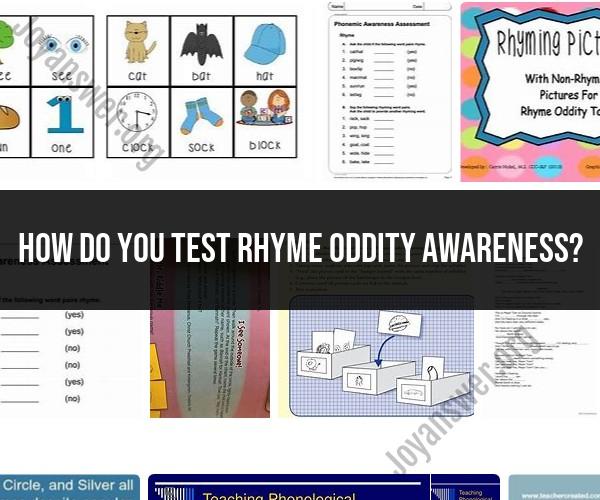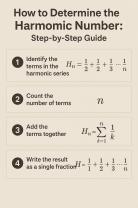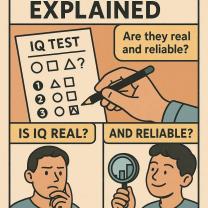How do you test rhyme oddity awareness?
Testing rhyme oddity awareness is a way to assess phonological skills, particularly a person's ability to recognize and manipulate the sounds of language. Rhyme oddity tasks are designed to determine whether an individual can identify the word that does not rhyme with the others in a set of words. Here's how you can test rhyme oddity awareness:
Materials Needed:
- A list of words (usually three or four words per set)
- Paper and a pen or a computer for recording responses
Procedure:
Select Words: Choose a set of words that have a clear rhyme pattern. For example, you might select words like "cat," "hat," "bat," and "dog" for a set.
Create Test Sets: Organize the words into sets with one word that does not rhyme with the others. In the example above, "dog" does not rhyme with the other words.
Present the Sets: One by one, present each set of words to the individual being tested. You can say the words aloud or provide them in written form, depending on the format of your test.
Ask for the Odd Word: Instruct the individual to identify and point out the word that does not rhyme with the others. You can say something like, "Which word doesn't rhyme with the others?"
Record Responses: Record the individual's responses. Note whether they correctly identify the word that does not rhyme.
Repeat with Multiple Sets: Repeat the process with several sets of words, varying the phonological patterns and the position of the odd word in the set. For instance, you might have sets like:
- Set 1: "cat," "bat," "dog" (odd word: "dog")
- Set 2: "book," "hook," "cook" (odd word: "book")
- Set 3: "pen," "hen," "cup" (odd word: "cup")
Assessment: Assess the individual's performance. A higher accuracy in identifying the odd word indicates a stronger rhyme oddity awareness and phonological skill.
Optional Variations: You can also vary the complexity of the test by using multisyllabic words or words with different consonant patterns. This can be especially useful for assessing more advanced phonological skills.
Interpretation: The results can help assess the individual's phonological awareness and their ability to recognize and manipulate the sounds within words. Strong performance in rhyme oddity tasks may suggest a higher level of phonological skill.
This type of assessment is often used in early childhood education, speech therapy, and language development research to gauge a person's phonological awareness, which is an important component of literacy skills. It can also be adapted for different age groups and skill levels, making it a versatile tool for assessing phonological skills.
Assessing Rhyme Oddity Awareness: Testing Methods and Tools
There are a number of different methods and tools that can be used to assess rhyme oddity awareness in children. One common method is to use a rhyme oddity task. In this task, the child is presented with three words, two of which rhyme and one of which does not. The child is then asked to identify the word that does not rhyme.
Another method of assessing rhyme oddity awareness is to use a rhyme production task. In this task, the child is presented with a word and asked to produce a word that rhymes with it.
There are a number of standardized tests that can be used to assess rhyme oddity awareness in children. One common test is the Blending Sounds Test. This test includes a subtest called the Rhyme Oddity Test, which consists of 10 items.
Rhyme Awareness Testing: Techniques and Strategies
When testing rhyme oddity awareness, it is important to use techniques and strategies that are appropriate for the child's age and developmental level. For example, younger children may need more support than older children.
Here are some tips for testing rhyme oddity awareness in children:
- Use simple, clear language.
- Use concrete examples.
- Give the child plenty of time to respond.
- Be patient and encouraging.
If the child is struggling, you can provide them with hints or prompts. For example, you can say, "Which word sounds different at the end?" or "Which word doesn't rhyme with the other two?"
Promoting Phonological Awareness: Evaluating Rhyme Oddity Skills
Rhyme oddity is an important phonological awareness skill. Phonological awareness is the ability to hear and manipulate the individual sounds in words. Phonological awareness is essential for reading development.
There are a number of activities that can be used to promote phonological awareness and evaluate rhyme oddity skills. Here are a few examples:
- Sing nursery rhymes and songs with the child.
- Play rhyming games.
- Ask the child to identify rhyming words.
- Ask the child to produce rhyming words.
- Use books with rhyming words.
By evaluating rhyme oddity skills, you can identify children who may need additional support in developing their phonological awareness skills.
Here are some additional tips for promoting rhyme oddity awareness in children:
- Make it fun! Children are more likely to engage in activities that are enjoyable.
- Be consistent. Set aside time each day to work on rhyme oddity awareness skills.
- Be patient. It takes time for children to develop their phonological awareness skills.
If you are concerned about a child's rhyme oddity awareness skills, talk to their teacher or a speech-language pathologist.












